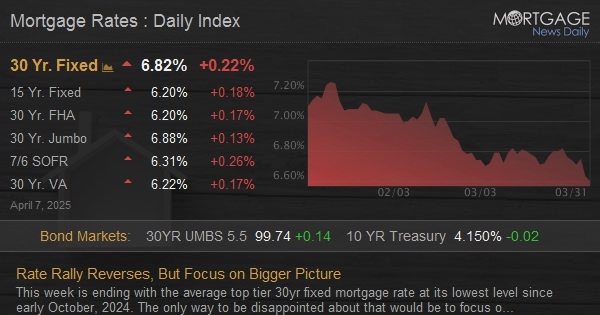This week, the average top-tier 30-year fixed mortgage rate reached its lowest point since early October 2024. Rates dropped sharply due to market reactions to a recent tariff announcement and China’s retaliatory measures. Initially, bonds strengthened, but gains were gradually lost. Key factors impacting the rate reversal included a strong jobs report, Vietnam’s decision to lower tariffs on the U.S., and Fed Chair Powell’s concerns about inflation from tariffs rather than any inclination to cut rates. While rates are low, the volatility in the market remains a concern as traders adjust their positions ahead of the weekend.
This week concludes with the average top-tier 30-year fixed mortgage rate at its lowest point since early October 2024. The only way to feel let down about this would be to focus on the fact that rates were even lower earlier this morning.
Rates saw a significant decline as a result of the market’s continued response to Wednesday’s tariff announcement, particularly following China’s overnight declaration of retaliatory tariffs. Bonds, which influence rates, began the day at their strongest levels during domestic trading but gradually lost those gains. What caused this shift?
There are several factors that could explain Friday’s rate reversal, including but not limited to three major events:
- A notably strong jobs report
- Reports that Vietnam plans to reduce tariffs on the U.S. (which served as evidence suggesting that tariffs might be less burdensome than initially feared)
- Fed Chair Powell expressing renewed worries about the inflationary effects of tariffs rather than indicating any willingness from the Fed to cut rates in response to economic challenges
Beyond these concrete factors, it’s also worth noting that rates made significant movements this week compared to their recent patterns, and it’s not uncommon for traders to consolidate their positions on a Friday afternoon (i.e., to pull back slightly on the existing trends).
Nonetheless, the average rate remains as low as it has been since October. If there’s any reason to be cautious, it’s that the nature of these influences suggests that volatility remains a clear risk, whether for better or worse.
